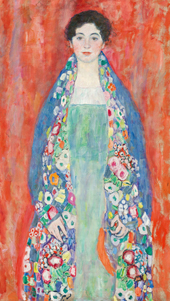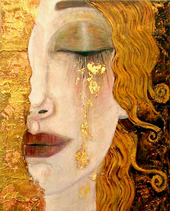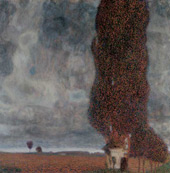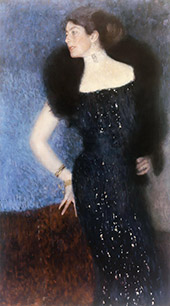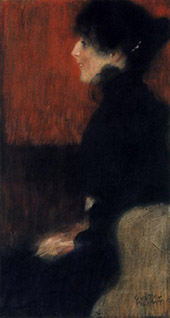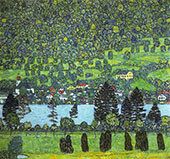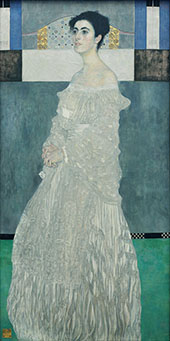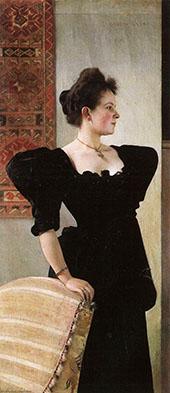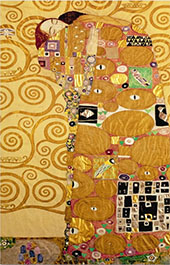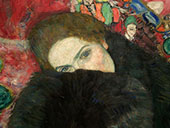Gustav Klimt Oil Painting Reproductions
Gustav Klimt replica paintings on Canvas for sale
Paintings by Gustav Klimt: An Artistic Biography
Klimt is known for his highly decorative Art Nouveau paintings. His art defines an era by characterizing the fin de siècle opulence of Austrian high society. Gustav Klimt gold leaf paintings epitomize this period.
Today, we explore Gustav Klimt’s intriguing personal life. Then, we’ll examine some of the most famous Gustav Klimt paintings and answer some commonly asked questions.
Where was Gustav Klimt born?
Born on 14 July 1862, Gustav Klimt spent his youth in Baumgarten. He lived in a small village outside Vienna with two brothers and four sisters.
His mother, Anna Klimt, was interested in music, while his father, Ernst Klimt, worked as a gold engraver. Gustav Klimt gold paintings may reflect his experience watching his father work and the inspiration for his later “gold phase.”
What is the first Gustav Klimt oil painting?
One of Klimt’s first known paintings is a landscape titled Secluded Pond (1881).
Klimt landscapes are mainly scenes from the Lake Garda area.
Gustav Klimt started painting while at the Vienna Kunstgewerbeschule. A leading school of applied arts, he studied architectural painting between 1876 and 1883. He particularly revered Hans Makart (Vienna’s leading history painter) during this time.
During his studies, Klimt produced conservative and academic paintings but soon moved on to large-scale murals.
Alongside his brother and their friend Franz Matsch, Klimt formed the “Company of Artists.” Together, they painted murals at the Kunsthistorisches Museum in Vienna and several public buildings on the Ringstraße.
By 1888, Klimt received a “Golden Order of Merit” from Franz Josef I of Austria for his murals on the Burgtheater in Vienna. His career flourished, and he became an honorary member of the Universities of Vienna and Munich.
Despite this success, Klimt’s father and brother both died in 1892. This tragedy shifted Klimt’s artistic style towards the darker, more symbolic subject matter. From this point onwards, Klimt often included classical nude women in his oil paintings. Nuda Veritas follows the tradition of Klimt's gold paintings.
Why is Gustav Klimt Famous?
Gustav Klimt is best known for his pioneering Art Nouveau paintings. In addition, he created many society portraits, including paintings of society beauties such as Margaret Wittgenstein and Marie Breunig.
Klimt is also known as one of the founding members of the Vienna Secession. He became President in 1897. As an art movement closely related to Art Nouveau, it brought many avant-garde painters, sculptors, and architects together.
These creatives resigned from the highly traditional Association of Austrian artists, protesting its strict control. Nevertheless, Gustav Klimt was heavily involved in the design of the Secession Building. He also completed the Beethoven Frieze in 1902 for the 14th Vienna Secessionist exhibition.
Painted directly on the building’s walls, it holds several intriguing details, including the “hostile forces” and a “choir of angels from paradise.” On the right-hand side wall, Klimt described how a couple “embrace for all the world.”
Allowing artists to work in any style they pleased, the Vienna Secession group adopted Pallas Athena (the Greek goddess of justice, wisdom, and the arts) as their symbol. Klimt painted his version of this legendary figure with Pallas Athene (1898).
Gustav Klimt Gold Leaf Paintings
Scholars believe Klimt’s travels to Venice and Ravenna (in Northern Italy) inspired his gold techniques. Both locations boast stunning mosaics, often using Byzantine imagery, as is apparent in Gustav Klimt’s flattened perspectives and decorative geometric designs.
In 1904, Klimt worked on decorations for the Palais Stoclet. The home of a wealthy Belgian industrialist, it formed one of the grandest monuments of the golden Art Nouveau age.
Klimt’s artworks for this building, notably his golden paintings in the dining room, are some of his most mature and skillful works. Gustav Klimt's The Tree of Life mural is “the ultimate stage of his development of ornament.”
Where are Gustav Klimt’s original paintings?
Gustav Klimt's famous paintings appear in museums all over the world.
The Neue Galerie in New York (with many posters, sketches, and prints), the National Portrait Gallery in London (home to Klimt’s Portrait of Hermine Gallia), and the Galleria Nazionale d’Arte Moderna e Contemporanea in Rome (displaying The Three Ages of Woman) all offer Gustav Klimt artwork.
Despite this, many paintings by Gustav Klimt are still in his native Austria.
The Belvedere Museum (in the Imperial palace of the Price of Savoy) holds the most extensive collection of famous Klimt paintings.
Paintings in the collection include Gustav Klimt's Judith, Portrait of Fritza Riedler, and course, Klimt's iconic painting The Kiss.
The Leopold Museum in Austria has a substantial collection, including his Attersee landscapes and one of Klimt’s last paintings, Death and Life.
In the late 1890s, Klimt took annual summer holidays at Kamersee (also known as Attersee or Lake Atter). A picturesque spot in Upper Austria, it is the location of many beautiful Klimt landscapes.
Aside from portraiture, landscape art was the only genre that truly interested Klimt. Scholars believe he created these Attersee works using a telescope. Indeed, he flattened deep perspectives into subtle shades of color, predating later abstract approaches.
What happened to the Klimt paintings?
Because many of Gustav Klimt artworks were murals, most have not survived. One example is the lost ceiling decorations in the University of Vienna’s Great Hall.
Sadly no longer in existence, Klimt’s paintings of Jurisprudence, Philosophy, and Medicine suffered critical disapproval upon unveiling. Eighty-seven faculty members protested in 1901. Described as “pornographic,” Klimt’s overtly sexualized work disturbed conventional morality.
Public outcry followed on artistic, political, and religious terms. Klimt took the rejection to heart and never accepted public commissions again. When German forces burned the Schloss Immendorf in May 1945, they destroyed all three paintings.
Klimt’s Beethoven Frieze is in the Vienna Secession building, and so are murals at the Kunsthistorisches Museum and the Burgtheater in Vienna.
Did Gustav Klimt use real gold in his paintings?
From the 1900s onwards, the artist entered his “Golden Phase," using real gold leaf in many of his oil paintings.
It was also a symbolic golden period for Gustav Klimt, marked by positive critical reactions and financial security.
While Klimt previously used gold in works such as Pallas Athene and Judith I. The two most famous paintings of this era are Portrait of Adele Block-Bauer, (Gustav Klimt woman in gold) and The Kiss.
What is Gustav Klimt’s best painting?
The Kiss by Gustav Klimt is the painter’s ultimate gold leaf artwork. Created in 1907, it represents the pinnacle of Gustav Klimt's gold leaf paintings and a genuinely unique double portrait. While art historians disagree on the woman’s identity, many believe it is an image of Klimt alongside Emilie Louise Flöge.
Given Flöge’s background in fashion design, the couple often worked together on costumes and outfits. Klimt often designed outfits with Flöge and she was the model in his paintings.
In addition to The Kiss, paintings like Danaë (1907) celebrate Klimt’s symbolist art.
In Greek mythology, Zeus visited Danaë in the form of a shower of golden rain resulting in the birth of their child, Perseus. However, Klimt’s portrayal proved controversial due to the woman’s apparent sexual arousal.
Klimt remained with the Vienna Secession until 1908, continuing to paint after this time. His 1911 painting Death and Life won first prize in the World Exhibition in Rome.
How many Gustav Klimt paintings are there?
Gustav Klimt painted over 160 oil paintings during his lifetime. Including collaborative murals and paper drawings, however, this number rises to well over 4,000 individual works.
These stunning creations still enjoy celebrity, and exhibitions take place worldwide.
Famous Nazi Art
During World War Two, the Nazis looted many Gustav Klimt paintings. As a result, these artworks are only returning to their rightful owners today.
Paintings include Gustav Klimt landscape paintings (such as Rosebushes Under the Trees), stolen from an Austrian Jewish family in 1938. The Musée d’Orsay in Paris only announced its intention to return the artwork to its rightful owners in 2021.
Another famous oil painting stolen during World War Two is Klimt’s portrait of Adele Bloch-Bauer. The painting was the subject of a lengthy legal battle launched by Ms. Bloch Bauer’s niece (Maria Altmann). Subsequent court proceedings eventually resulted in the painting’s return to the family in 2011.
When Did Gustav Klimt Die?
Klimt died on 6 February 1918 in his home city of Vienna. He suffered a stroke and consequent pneumonia during the worldwide influenza epidemic. Buried at the Hietzinger Cemetery in Hietzing, Vienna, Klimt left many unfinished paintings on his death.
Klimt also met the fashion designer Emilie Louise Flöge in the early 1890s. Although they were never married, she remained his companion until the end of his life.
Gustav Klimt Famous Paintings: Fine Art Reproductions
If you love paintings by Gustav Klimt, explore our extensive collection of art reproductions.
As well as the best Klimt reproduction fine art oil paintings, we also boast a wide array of Art Nouveau paintings from Alphonse Mucha, Gerda Wegener, and more.
Discover Klimt's gold leaf paintings and famous landscape paintings to suit any home or office.
Testimonial from Candy C, The Villages, Florida
Cannot Find What You Are Looking For?
Reproduction Gallery Information
Customer Service
(Send Us A Message)
Tel: (503) 937 2010
Fax: (503) 937 2011




